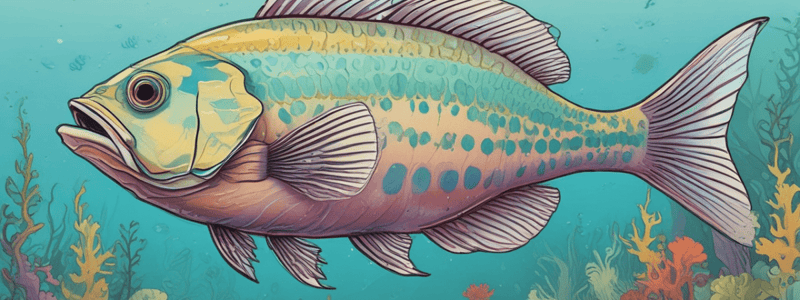Podcast
Questions and Answers
What mechanism do marine fish use to conserve water and remove excess salt?
What mechanism do marine fish use to conserve water and remove excess salt?
- Producing a dilute urine
- Excreting salt through the kidneys
- Drinking water and producing a concentrated urine (correct)
- Removing salt through the skin
What adaptation allows some aquatic invertebrates to survive in temporary pools with limited water?
What adaptation allows some aquatic invertebrates to survive in temporary pools with limited water?
- Hyperosmotic regulation
- Osmosis
- Hypoosmotic regulation
- Anhydrobiosis (correct)
How do terrestrial animals replace lost water?
How do terrestrial animals replace lost water?
- Through photosynthesis
- By drinking water and eating hydrating foods (correct)
- Through the process of cellular respiration
- By absorbing water from the air
What type of cells are specialized for moving solutes in specific directions?
What type of cells are specialized for moving solutes in specific directions?
How do aquatic organisms release ammonia?
How do aquatic organisms release ammonia?
What is the main form of nitrogenous waste excreted by insects, land snails, and many reptiles?
What is the main form of nitrogenous waste excreted by insects, land snails, and many reptiles?
What is the primary function of nasal glands in marine birds?
What is the primary function of nasal glands in marine birds?
What type of environment do freshwater fish live in, and how do they regulate their body fluid?
What type of environment do freshwater fish live in, and how do they regulate their body fluid?
What is the primary function of the glomerulus in the nephron?
What is the primary function of the glomerulus in the nephron?
What is the purpose of the descending limb of the loop of Henle?
What is the purpose of the descending limb of the loop of Henle?
What is the function of the proximal convoluted tubule in the nephron?
What is the function of the proximal convoluted tubule in the nephron?
What is the function of metanephridia in annelids?
What is the function of metanephridia in annelids?
What is the function of antennal glands in crustaceans?
What is the function of antennal glands in crustaceans?
What is the function of Malpighian tubules in insects and spiders?
What is the function of Malpighian tubules in insects and spiders?
What is the function of protonephridia in flatworms and nematodes?
What is the function of protonephridia in flatworms and nematodes?
What is the function of the nephron in vertebrate kidneys?
What is the function of the nephron in vertebrate kidneys?
What is the primary function of osmotic regulation in animals?
What is the primary function of osmotic regulation in animals?
Which of the following marine invertebrates is an example of an osmotic conformer?
Which of the following marine invertebrates is an example of an osmotic conformer?
What is anhydrobiosis, and in which organisms is it commonly found?
What is anhydrobiosis, and in which organisms is it commonly found?
What is the primary function of transport epithelia in animals?
What is the primary function of transport epithelia in animals?
Which of the following organisms is an example of a stenohaline species?
Which of the following organisms is an example of a stenohaline species?
What is the primary mechanism of nitrogenous waste management in fish?
What is the primary mechanism of nitrogenous waste management in fish?
What is the primary difference between euryhaline and stenohaline species?
What is the primary difference between euryhaline and stenohaline species?
Which of the following is NOT a characteristic of hypertonic environments?
Which of the following is NOT a characteristic of hypertonic environments?
Flashcards are hidden until you start studying
Study Notes
Osmotic Regulation
- Osmosis: movement of water molecules from areas of high water concentration to areas of low water concentration
- Environment classification:
- Hypertonic: higher solute and lower water concentration
- Hypotonic: lower solute and higher water concentration
- Isotonic: equal water and solute concentration (ideal for most animal cells)
- Osmotic regulation: maintaining an isotonic environment internally
Marine Fish Osmotic Regulation
- Hypertonic environment: constant water loss and salt uptake by hypoosmotic regulation
- Strategies:
- Drinking water
- Producing concentrated urine
- Excreting salt through gills by active transport
Freshwater Fish Osmotic Regulation
- Hypotonic environment: constant salt and mineral loss and water uptake by hyperosmotic regulation
- Strategies:
- Drinking limited water
- Producing diluted urine
Terrestrial Animals
- Water loss: evaporation, excretion in urine and feces
- Water replacement: food, drinking, and metabolic water (from cellular respiration)
Anhydrobiosis
- Adaptation in aquatic invertebrates to survive in temporary pools
- Example: Tardigrades
Excretory Systems
- Transport epithelia: specialized cells for solute movement
- Function: regulate solute content of body fluids
- Examples:
- Nasal glands of marine birds (remove excess sodium chloride from blood)
Nitrogenous Wastes
- Aquatic organisms: release ammonia across body surface or gills
- Mammals and adult amphibians: convert ammonia to urea in the liver
- Insects, land snails, and reptiles: excrete uric acid
Excretory System Functions
- Filtration: filtering body fluids
- Reabsorption: reclaiming valuable solutes
- Secretion: adding nonessential solutes and wastes to filtrate
- Excretion: processed filtrate containing nitrogenous wastes
Invertebrate Excretory Systems
- Protonephridia (flatworms, nematodes, rotifers): collects body fluids through collecting tubules
- Metanephridia (annelids): more sophisticated system with two openings and blood vessel network
- Antennal glands (green glands): reabsorbs salts prior to excretion
- Malpighian tubules (insects and spiders): secrete insoluble uric acid
Vertebrate Kidneys
- Functional unit: nephron
- Physiological functions:
- Filtration
- Reabsorption
- Secretion
- Excretion
Nephron Function
- Glomerulus: produces protein-free filtrate
- Proximal convoluted tubule: reabsorbs 60% of filtrate (H2O, glucose, amino acids, and vitamins)
- Descending limb of loop of Henle: permeable to water and impermeable to NaCl
Studying That Suits You
Use AI to generate personalized quizzes and flashcards to suit your learning preferences.




